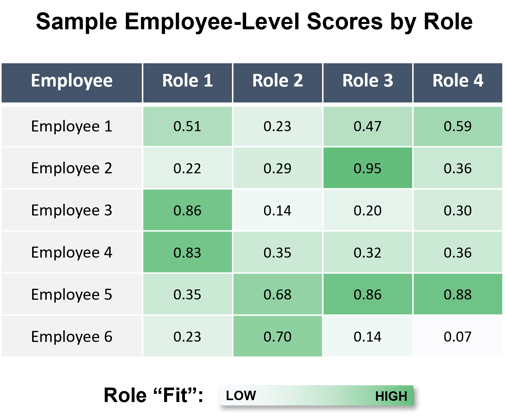The organization was transitioning from generalist to functionally aligned specialist roles. As the specialist roles would be staffed from a pool of nearly 1,500 generalist employees, leadership needed to identify the most experienced and skilled employees for each role. In practice, the generalist role was performed differently across teams making it difficult to know the true task-level capability of each employee. Furthermore, employee-level performance assessments were often incomplete or irrelevant to the requirements of the new roles. Ensuring optimal reassignment would require quickly gathering employee capability and skill-level information and developing a scalable approach for employee selection.
WP&C began by cataloguing the full scope of job duties within the current generalist roles using a comprehensive inventory of all tasks performed and quantifying the amount of time employees currently spent on each. The time allocation for each employee was then compared to the expected time allocation of the specialist roles to identify which role most closely matched each employee’s existing day-to-day duties. Then, to determine capability to perform the new roles, WP&C gathered supervisor input on employee skill level for each of tasks executed by the specialist roles.
Next, WP&C built a model to recommend new role assignments. The model used the employee experience and supervisor skill assessment data to calculate a composite “fit” score between each employee and specialist role. Since the score was calculated for each combination of employee and specialist role, the model provided leadership with a prioritized list of potential assignments for each employee.
For example, in the exhibit below, the model indicates that Employee 5 is best suited for Role 4, but also a strong fit for Role 3. In contrast, Employee 2 is most qualified for Role 3, while other roles would result in significant employee capability gaps. Using these employee-level scores, the model selected the assignments which optimized the overall employee-to-role fit for the organization.
Finally, WP&C facilitated workshops with leaders where the model outputs were reviewed, and final employee assignments were made. During these reviews, the model also enabled leadership to identify the prioritized training needs at the employee and task level based on final assignments.

To make optimal staffing selections to support reorganization, WP&C recommended the following:
- Develop a complete, employee-level fact base reflecting the critical selection criteria relevant for the roles
- When employee information is not available, use creative and scalable data collection methods such as surveys
- To ensure leadership and organizational buy-in, involve key client stakeholders to develop and validate the model and assignment assumptions
- Balance rigorous analytics with leadership input and first-hand knowledge of the individual employee capabilities to make role assignments
- Use the underlying model data to identify potential areas of training needs based on final selections
- Review selection decisions 90 to 180 days after implementation to ensure employee fit

